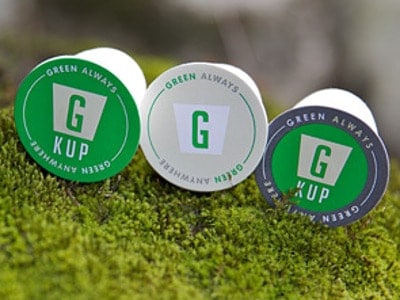
 Vancouver-based G-Kup is on the verge of easing that guilt you feel each time you toss a single-serve coffee pod into the trash.
Vancouver-based G-Kup is on the verge of easing that guilt you feel each time you toss a single-serve coffee pod into the trash.
Last month, K-Cup inventor John Sylvan expressed regret for his role in creating a single-serve, non-recyclable, extremely convenient monster, which accounted for over 10 billion discarded K-Cups in landfills last year.
He might also regret the fact that he sold his stake in the company back in 1997 for a measly $50,000, seeing as Kuerig Green Mountain posted revenue of $4.7 billion last year, but that’s perhaps another story.
With coffee pod sales forecast to soar north of $5 billion by 2018, Kuerig’s incentive to change is not very pressing, other than from a PR or optics perspective.
And even with their deep pockets, the coffee giant says it won’t be able to develop a green alternative for guilt-racked consumers before 2022.
So it’s a pleasant surprise that a Vancouver entrepreneur, working in collaboration with UBC’s Composites Research Network and 3D printing company Tinkerine, seems to have developed a green solution to K-Cup woes, the challenges for which are not small.
As G-Kup CEO Darren Footz, former president of Granville Island Coffee, described to Cantech Letter recently, “You’ve got elements in a single-serve Kuerig machine that are in opposition to biodegradability. You’ve got heat, water and pressure. Petroleum-based products can perform, and everything else has trouble.”
Several recent tech developments needed to line up in order for Footz and his team to develop the G-Kup, including the introduction of new materials to replace petroleum products, like bagasse, a byproduct of sugar cane processing.
“Things have changed in the last few years,” says Footz. “Fibre moulding is new, especially in the packaging industry. Bagasse and bamboo are now being moulded offshore for packaging solutions, whether it’s restaurant takeaway containers or home meal replacements. These types of solutions are new. So I looked at this new kind of technology in packaging and how it could be applied to the K-Cup.”
In 2003, NatureWorks introduced a plant-based polymer called Ingeo, a plant fibre-based biopolymer which has gone a long way towards greening disposable packaging.
“My goal is to make sure that G-Kup is not a substitute, but a complete replacement for K-Cup.” G-Kup CEO Darren Footz
And then there’s the advent of 3D printing, a technology which has advanced from barely a glimmer in the eye only a few years ago to being on the verge of revolutionizing the manufacturing process today.
Whereas the trial-and-error process of developing a working model would have cost between $2,000-$5,000 for each iteration involving a mould maker just a few years ago, 3D printing allows Footz and his G-Kup team to adjust their commercial design quickly and cheaply.
“We worked very closely with Tinkerine, the Vancouver 3D printing manufacturer, not just from the printing side, but actually from the 3D modelling side,” says Footz. “It’s one thing to have a great idea and sketch it in two dimensions on a napkin. It’s a little bit more of a learning curve to make that idea into a 3D model, work with it, make different iterations, but to take that same digital sketch and print it in reality.”
Those technological developments, along with some federal funding for UBC’s Composites Research Network, have facilitated G-Kup’s path to innovation. And with the CRN on the verge of finalizing the G-Kup’s design, “hopefully by August” says Footz, there’s little standing in G-Kup’s way to the disruption of Kuerig’s $18 billion market cap.
In 2012, the patent on the K-Cup expired, opening it up to competitors. With that final obstacle removed, the pressure falls to whoever can develop a green replacement and be first to market.
No small task, though, given the challenge of developing a non-petroleum pod designed to withstand the heat, pressure and water of a coffee machine.
Asked why he was able to develop a green replacement for the K-Cup so far ahead of Green Mountain’s self-imposed deadline of 2022, Footz says, “I think what’s happened is this company has become so big, they’re not nimble.”
So, is the G-Kup meant to be complementary to Kuerig’s non-green product, niche marketed to green-leaning consumers? No, says Footz, who won’t be happy until Kuerig’s product is eliminated from the marketplace.
“My goal is to make sure that G-Kup is not a substitute, but a complete replacement for K-Cup,” he says. “We would like to see K-Cup removed from store shelves. We want to see K-Cup removed from the marketplace. And the best way to get there depends on what kind of strategic partnerships we think we should do.”
Finally, though, it comes down to whether the product delivers a taste experience combined with the convenience that consumers have gotten used to with K-Cups.
“Being sustainable is part of our mandate, our philosophy,” he says, “but if you can’t get as good or better a cup of coffee from G-Kup, as opposed to K-Cup, then we don’t believe the consumer is going to adopt this device.”
Comment
Leave a Reply
You must be logged in to post a comment.



 Share
Share Tweet
Tweet Share
Share




Where can we buy it ? Hope Costco ! 80 to the box for $39
Hi Carol. The G-Kup is not for sale just yet. Get to fb.com/gkupcoffee for the latest updates.